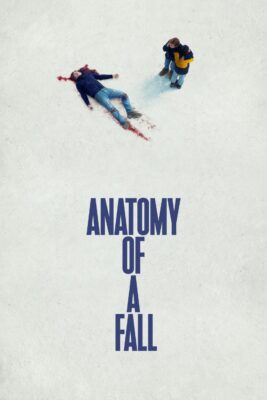

“After a while, I can tell what’s real and what isn’t.”
“Lucky you.”
It’s no surprise that our post-truth culture esteems a film like Anatomy of a Fall, which concerns the unfruitful legal proceedings following the mysterious death of a man (Samuel Theis) who may have accidentally fallen from his mountain cabin’s third story loft, or committed suicide, or been murdered by his wife (Sandra Hüller).
Our perception of things and their true nature are often at odds—that’s the theme that writer-director Justine Triet underscores time and again as we witness the aggressive French prosecutor (Antoine Reinartz) and his procession of leading questions, speculations, scale model houses, 3D renderings, and on-site reenactments. (I’ll concur with a bunch of other ignorant American critics who find the French courtroom proceeding deeply disturbing due to its utter unfamiliarity, though the free-for-all nature of the questions certainly supports the film’s philosophy.) Much is made of the wavering testimony of the couple’s sight-impaired son (Milo Machado-Graner), whose disability carries an obvious symbolic weight, while the defense lawyer’s (Swann Arlaud) dubious intentions toward his client and the accused’s pseudo-seduction of a student (Camille Rutherford) complexify the trial.
The most insightful segment stems from an audio recording that gets rendered in flashback: an argument between the warring couple, about the woman’s impositions that have stifled the man’s creative aspirations. He believes that he has sacrificed his entire life to raise their son and support her writing career—evidenced by the facts that he homeschools the boy and allowed her to use the “best idea” from his abandoned novel as the basis for her own bestseller—while she posits that he takes on extra burdens so that he won’t have to earnestly face his crippling writer’s block and that she doesn’t owe their marriage anything (as the lawyers and prosecution squabble over the definition of “seduction,” one wonders what these people understand to define a “marriage”).
The courtroom discussion regarding this secret recording delves into an artist’s tendency to base their work on their own lives and how art functions not only as a form of self-understanding but also self-actualization—the artist creating himself, so to speak. For the most part, however, it revels in its state of unknowing as it delves into a hateful marriage.
It’s a philosophical point that fails to strike quite as profoundly as the film believes it does because it is not applied to an appropriate subject, such as the hard problem of consciousness, for instance. It isn’t the case that we can’t know the details of the husband’s death, but that we don’t know them simply because the screenplay is contrived to keep them from us. The drops of blood might have been from an impact on the shed roof. Maybe the physical evidence disappeared with the melting of the snow. It’s possible that the music was loud enough to obscure the conversation that the son was certain he had heard.
Many films play this game, of course, then again, most of them use such subterfuge to entertain or toward some other end than endlessly circling around the same abstract point. For these characters (and if we want to read into the commentary on the artist’s work being their life, also the filmmaker), there is no foundational truth to anything. Any belief is valid, and the truth is merely the one that’s agreed upon. Such an approach to life reduces knowledge to the individual’s “truth”—the husband convincing himself that his familial responsibilities preclude a creative life, the wife believing she has a right to infidelity and a duty to her career, or the son deciding which speculative narrative to confirm in his memory. These half-explored side trails are a much more interesting application of the idea than the central murder investigation—especially because there’s clearly not enough evidence for the suspect to be convicted, however despicable she may be—and thus Anatomy of a Fall, while extremely well acted, offers limited insight on its central theme, and thus rings hollow.